Damage-Based Assessment for Performance-Based Design Timber Earthquake
VerifiedAdded on 2022/12/26
|26
|5950
|63
Report
AI Summary
This report, submitted by Shreya Regmi from the University of Melbourne, investigates damage-based assessment for performance-based design and analysis of timber structures under earthquake loads. It begins with an abstract summarizing the study's focus on mitigating casualties and economic losses caused by earthquakes, emphasizing the importance of structural materials and design. The introduction highlights timber as a construction material and discusses seismic loads, design considerations, and the need for improved understanding of timber's seismic response. The report reviews the background of timber structures, comparing them with steel and concrete and discussing the advantages of timber, such as high strength-to-weight ratio and energy dissipation. The objective of the study is to evaluate the performance of timber buildings using a damage-based approach under earthquake loads, identifying different damage models and evaluating the damage-based approach. The report explores the shift from displacement-based to damage-based procedures and examines existing damage models, data sheet requirements, and dynamic structural models. A literature review is presented, including recent numerical and experimental research works on timber structures, such as shake table tests and numerical analysis. The report also compares force-based, displacement-based, and damage-based design approaches. The proposed design focuses on the Park-Ang Damage Model, which considers cumulative damage failure and initial exceedance failure. The assignment aims to improve the seismic performance of timber buildings by using a damage-based approach under earthquake loads.
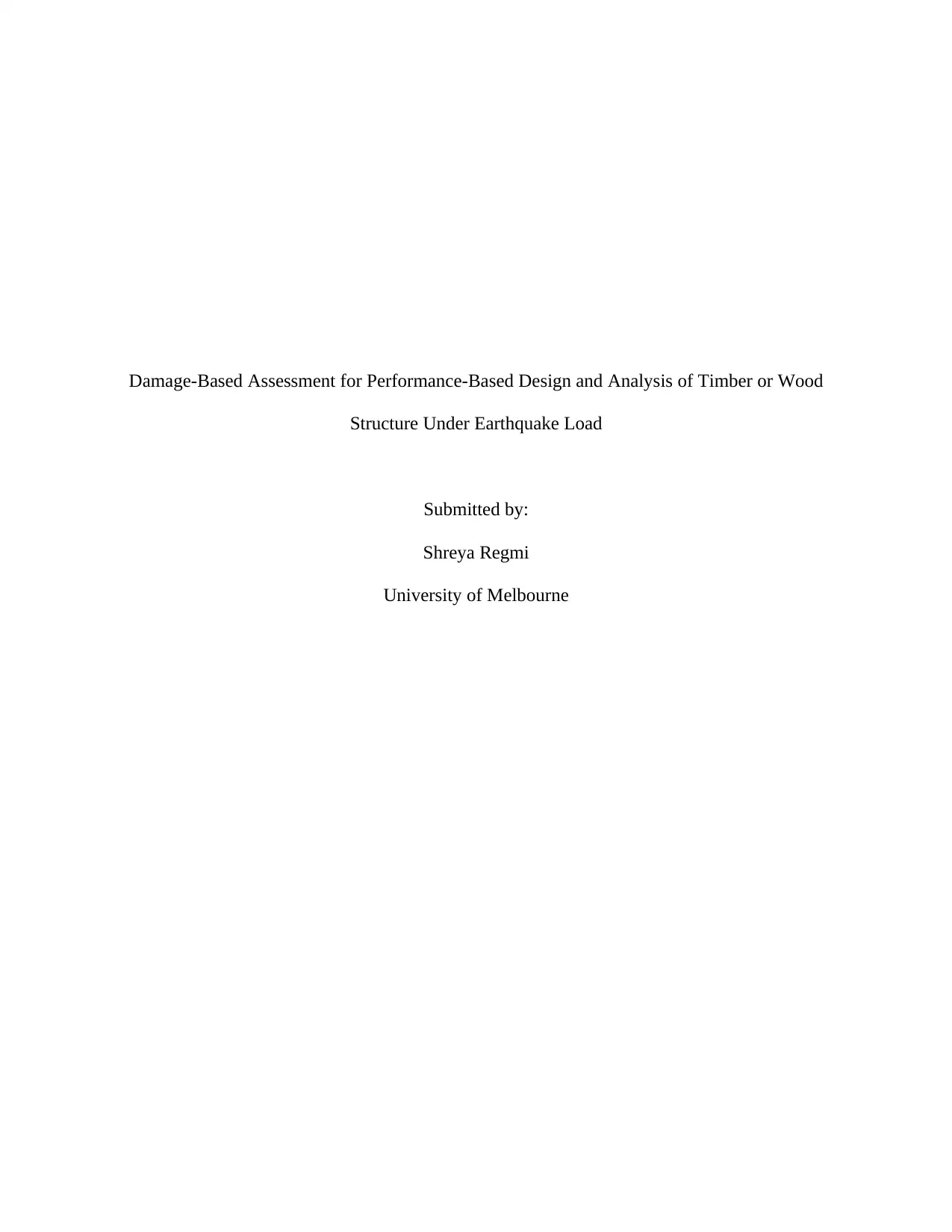
Damage-Based Assessment for Performance-Based Design and Analysis of Timber or Wood
Structure Under Earthquake Load
Submitted by:
Shreya Regmi
University of Melbourne
Structure Under Earthquake Load
Submitted by:
Shreya Regmi
University of Melbourne
Paraphrase This Document
Need a fresh take? Get an instant paraphrase of this document with our AI Paraphraser
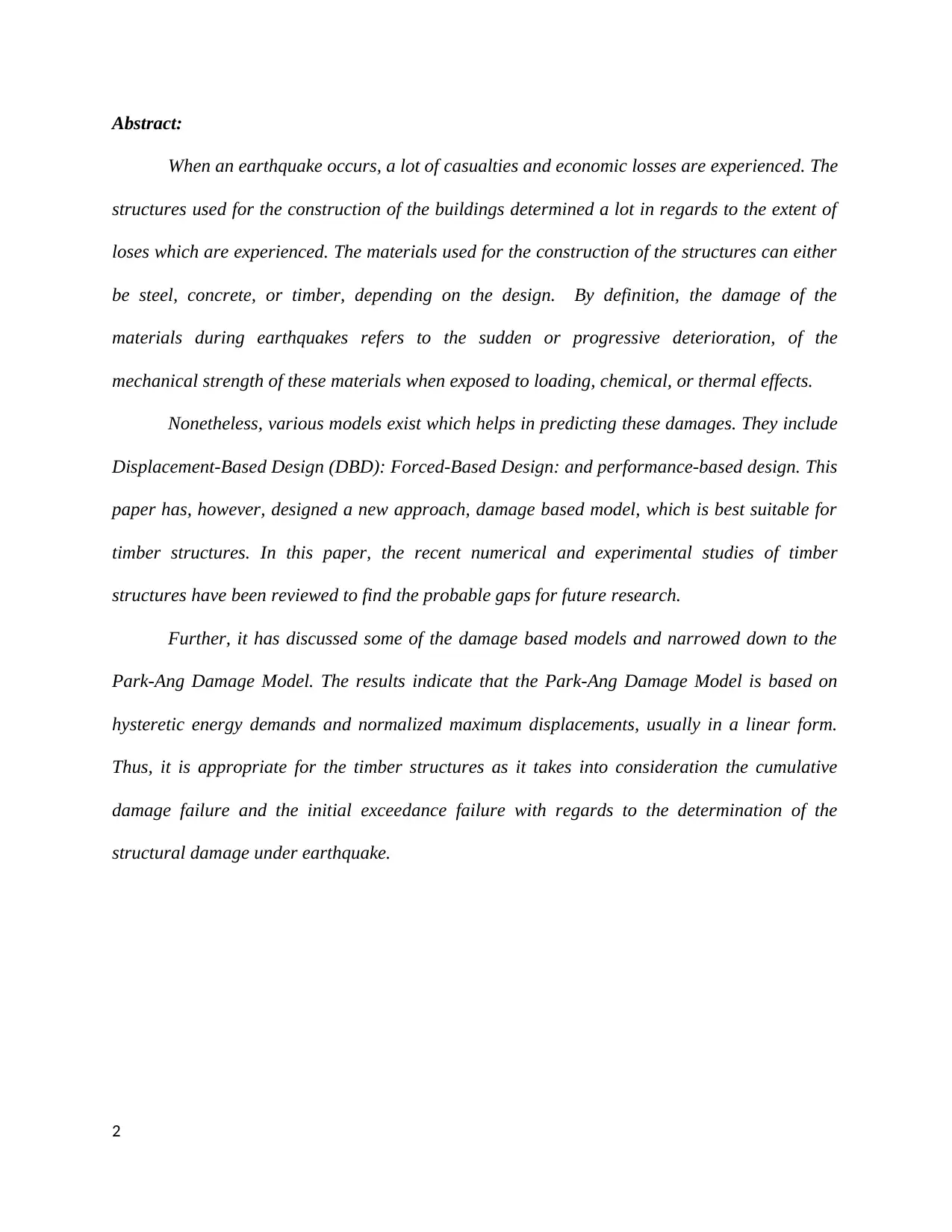
Abstract:
When an earthquake occurs, a lot of casualties and economic losses are experienced. The
structures used for the construction of the buildings determined a lot in regards to the extent of
loses which are experienced. The materials used for the construction of the structures can either
be steel, concrete, or timber, depending on the design. By definition, the damage of the
materials during earthquakes refers to the sudden or progressive deterioration, of the
mechanical strength of these materials when exposed to loading, chemical, or thermal effects.
Nonetheless, various models exist which helps in predicting these damages. They include
Displacement-Based Design (DBD): Forced-Based Design: and performance-based design. This
paper has, however, designed a new approach, damage based model, which is best suitable for
timber structures. In this paper, the recent numerical and experimental studies of timber
structures have been reviewed to find the probable gaps for future research.
Further, it has discussed some of the damage based models and narrowed down to the
Park-Ang Damage Model. The results indicate that the Park-Ang Damage Model is based on
hysteretic energy demands and normalized maximum displacements, usually in a linear form.
Thus, it is appropriate for the timber structures as it takes into consideration the cumulative
damage failure and the initial exceedance failure with regards to the determination of the
structural damage under earthquake.
2
When an earthquake occurs, a lot of casualties and economic losses are experienced. The
structures used for the construction of the buildings determined a lot in regards to the extent of
loses which are experienced. The materials used for the construction of the structures can either
be steel, concrete, or timber, depending on the design. By definition, the damage of the
materials during earthquakes refers to the sudden or progressive deterioration, of the
mechanical strength of these materials when exposed to loading, chemical, or thermal effects.
Nonetheless, various models exist which helps in predicting these damages. They include
Displacement-Based Design (DBD): Forced-Based Design: and performance-based design. This
paper has, however, designed a new approach, damage based model, which is best suitable for
timber structures. In this paper, the recent numerical and experimental studies of timber
structures have been reviewed to find the probable gaps for future research.
Further, it has discussed some of the damage based models and narrowed down to the
Park-Ang Damage Model. The results indicate that the Park-Ang Damage Model is based on
hysteretic energy demands and normalized maximum displacements, usually in a linear form.
Thus, it is appropriate for the timber structures as it takes into consideration the cumulative
damage failure and the initial exceedance failure with regards to the determination of the
structural damage under earthquake.
2
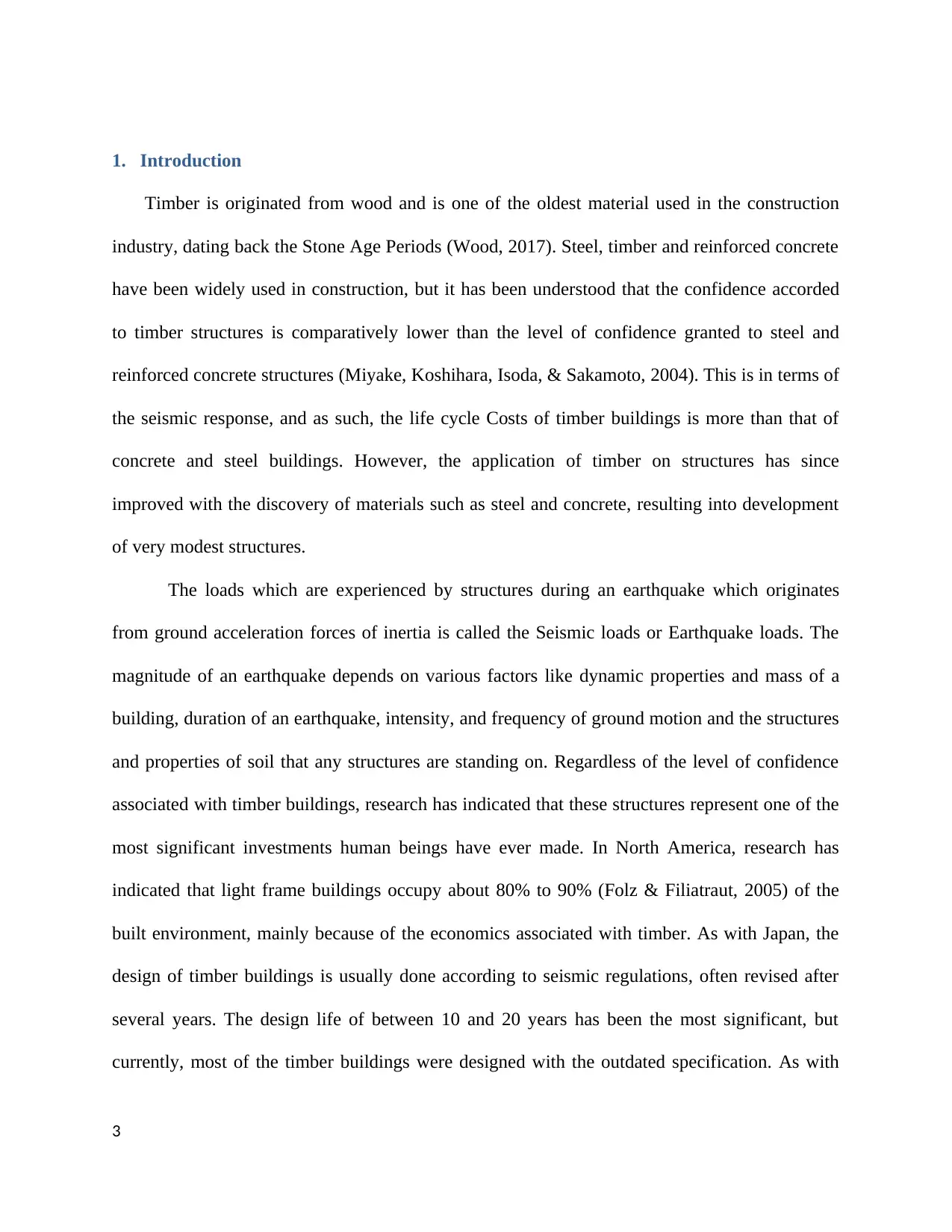
1. Introduction
Timber is originated from wood and is one of the oldest material used in the construction
industry, dating back the Stone Age Periods (Wood, 2017). Steel, timber and reinforced concrete
have been widely used in construction, but it has been understood that the confidence accorded
to timber structures is comparatively lower than the level of confidence granted to steel and
reinforced concrete structures (Miyake, Koshihara, Isoda, & Sakamoto, 2004). This is in terms of
the seismic response, and as such, the life cycle Costs of timber buildings is more than that of
concrete and steel buildings. However, the application of timber on structures has since
improved with the discovery of materials such as steel and concrete, resulting into development
of very modest structures.
The loads which are experienced by structures during an earthquake which originates
from ground acceleration forces of inertia is called the Seismic loads or Earthquake loads. The
magnitude of an earthquake depends on various factors like dynamic properties and mass of a
building, duration of an earthquake, intensity, and frequency of ground motion and the structures
and properties of soil that any structures are standing on. Regardless of the level of confidence
associated with timber buildings, research has indicated that these structures represent one of the
most significant investments human beings have ever made. In North America, research has
indicated that light frame buildings occupy about 80% to 90% (Folz & Filiatraut, 2005) of the
built environment, mainly because of the economics associated with timber. As with Japan, the
design of timber buildings is usually done according to seismic regulations, often revised after
several years. The design life of between 10 and 20 years has been the most significant, but
currently, most of the timber buildings were designed with the outdated specification. As with
3
Timber is originated from wood and is one of the oldest material used in the construction
industry, dating back the Stone Age Periods (Wood, 2017). Steel, timber and reinforced concrete
have been widely used in construction, but it has been understood that the confidence accorded
to timber structures is comparatively lower than the level of confidence granted to steel and
reinforced concrete structures (Miyake, Koshihara, Isoda, & Sakamoto, 2004). This is in terms of
the seismic response, and as such, the life cycle Costs of timber buildings is more than that of
concrete and steel buildings. However, the application of timber on structures has since
improved with the discovery of materials such as steel and concrete, resulting into development
of very modest structures.
The loads which are experienced by structures during an earthquake which originates
from ground acceleration forces of inertia is called the Seismic loads or Earthquake loads. The
magnitude of an earthquake depends on various factors like dynamic properties and mass of a
building, duration of an earthquake, intensity, and frequency of ground motion and the structures
and properties of soil that any structures are standing on. Regardless of the level of confidence
associated with timber buildings, research has indicated that these structures represent one of the
most significant investments human beings have ever made. In North America, research has
indicated that light frame buildings occupy about 80% to 90% (Folz & Filiatraut, 2005) of the
built environment, mainly because of the economics associated with timber. As with Japan, the
design of timber buildings is usually done according to seismic regulations, often revised after
several years. The design life of between 10 and 20 years has been the most significant, but
currently, most of the timber buildings were designed with the outdated specification. As with
3
⊘ This is a preview!⊘
Do you want full access?
Subscribe today to unlock all pages.

Trusted by 1+ million students worldwide
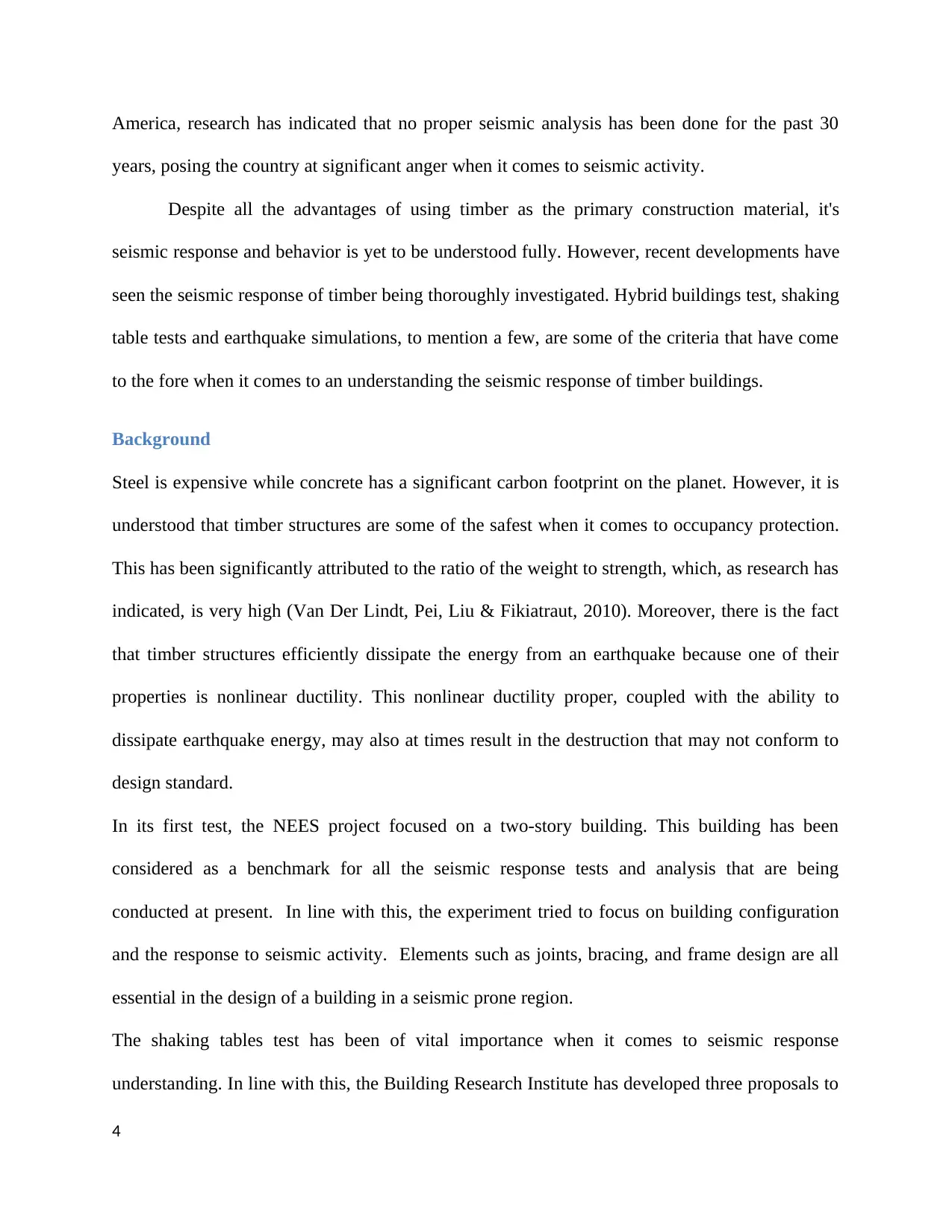
America, research has indicated that no proper seismic analysis has been done for the past 30
years, posing the country at significant anger when it comes to seismic activity.
Despite all the advantages of using timber as the primary construction material, it's
seismic response and behavior is yet to be understood fully. However, recent developments have
seen the seismic response of timber being thoroughly investigated. Hybrid buildings test, shaking
table tests and earthquake simulations, to mention a few, are some of the criteria that have come
to the fore when it comes to an understanding the seismic response of timber buildings.
Background
Steel is expensive while concrete has a significant carbon footprint on the planet. However, it is
understood that timber structures are some of the safest when it comes to occupancy protection.
This has been significantly attributed to the ratio of the weight to strength, which, as research has
indicated, is very high (Van Der Lindt, Pei, Liu & Fikiatraut, 2010). Moreover, there is the fact
that timber structures efficiently dissipate the energy from an earthquake because one of their
properties is nonlinear ductility. This nonlinear ductility proper, coupled with the ability to
dissipate earthquake energy, may also at times result in the destruction that may not conform to
design standard.
In its first test, the NEES project focused on a two-story building. This building has been
considered as a benchmark for all the seismic response tests and analysis that are being
conducted at present. In line with this, the experiment tried to focus on building configuration
and the response to seismic activity. Elements such as joints, bracing, and frame design are all
essential in the design of a building in a seismic prone region.
The shaking tables test has been of vital importance when it comes to seismic response
understanding. In line with this, the Building Research Institute has developed three proposals to
4
years, posing the country at significant anger when it comes to seismic activity.
Despite all the advantages of using timber as the primary construction material, it's
seismic response and behavior is yet to be understood fully. However, recent developments have
seen the seismic response of timber being thoroughly investigated. Hybrid buildings test, shaking
table tests and earthquake simulations, to mention a few, are some of the criteria that have come
to the fore when it comes to an understanding the seismic response of timber buildings.
Background
Steel is expensive while concrete has a significant carbon footprint on the planet. However, it is
understood that timber structures are some of the safest when it comes to occupancy protection.
This has been significantly attributed to the ratio of the weight to strength, which, as research has
indicated, is very high (Van Der Lindt, Pei, Liu & Fikiatraut, 2010). Moreover, there is the fact
that timber structures efficiently dissipate the energy from an earthquake because one of their
properties is nonlinear ductility. This nonlinear ductility proper, coupled with the ability to
dissipate earthquake energy, may also at times result in the destruction that may not conform to
design standard.
In its first test, the NEES project focused on a two-story building. This building has been
considered as a benchmark for all the seismic response tests and analysis that are being
conducted at present. In line with this, the experiment tried to focus on building configuration
and the response to seismic activity. Elements such as joints, bracing, and frame design are all
essential in the design of a building in a seismic prone region.
The shaking tables test has been of vital importance when it comes to seismic response
understanding. In line with this, the Building Research Institute has developed three proposals to
4
Paraphrase This Document
Need a fresh take? Get an instant paraphrase of this document with our AI Paraphraser
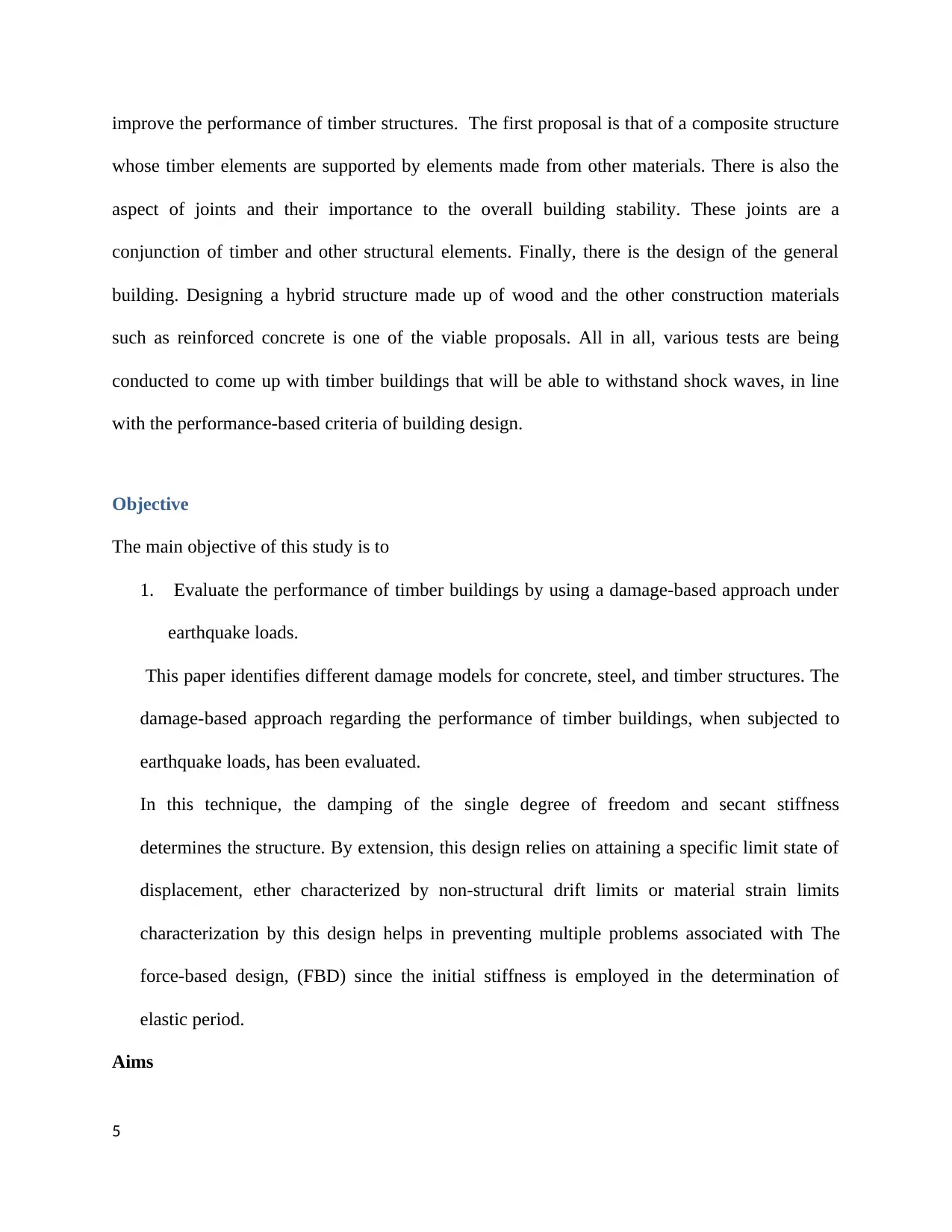
improve the performance of timber structures. The first proposal is that of a composite structure
whose timber elements are supported by elements made from other materials. There is also the
aspect of joints and their importance to the overall building stability. These joints are a
conjunction of timber and other structural elements. Finally, there is the design of the general
building. Designing a hybrid structure made up of wood and the other construction materials
such as reinforced concrete is one of the viable proposals. All in all, various tests are being
conducted to come up with timber buildings that will be able to withstand shock waves, in line
with the performance-based criteria of building design.
Objective
The main objective of this study is to
1. Evaluate the performance of timber buildings by using a damage-based approach under
earthquake loads.
This paper identifies different damage models for concrete, steel, and timber structures. The
damage-based approach regarding the performance of timber buildings, when subjected to
earthquake loads, has been evaluated.
In this technique, the damping of the single degree of freedom and secant stiffness
determines the structure. By extension, this design relies on attaining a specific limit state of
displacement, ether characterized by non-structural drift limits or material strain limits
characterization by this design helps in preventing multiple problems associated with The
force-based design, (FBD) since the initial stiffness is employed in the determination of
elastic period.
Aims
5
whose timber elements are supported by elements made from other materials. There is also the
aspect of joints and their importance to the overall building stability. These joints are a
conjunction of timber and other structural elements. Finally, there is the design of the general
building. Designing a hybrid structure made up of wood and the other construction materials
such as reinforced concrete is one of the viable proposals. All in all, various tests are being
conducted to come up with timber buildings that will be able to withstand shock waves, in line
with the performance-based criteria of building design.
Objective
The main objective of this study is to
1. Evaluate the performance of timber buildings by using a damage-based approach under
earthquake loads.
This paper identifies different damage models for concrete, steel, and timber structures. The
damage-based approach regarding the performance of timber buildings, when subjected to
earthquake loads, has been evaluated.
In this technique, the damping of the single degree of freedom and secant stiffness
determines the structure. By extension, this design relies on attaining a specific limit state of
displacement, ether characterized by non-structural drift limits or material strain limits
characterization by this design helps in preventing multiple problems associated with The
force-based design, (FBD) since the initial stiffness is employed in the determination of
elastic period.
Aims
5
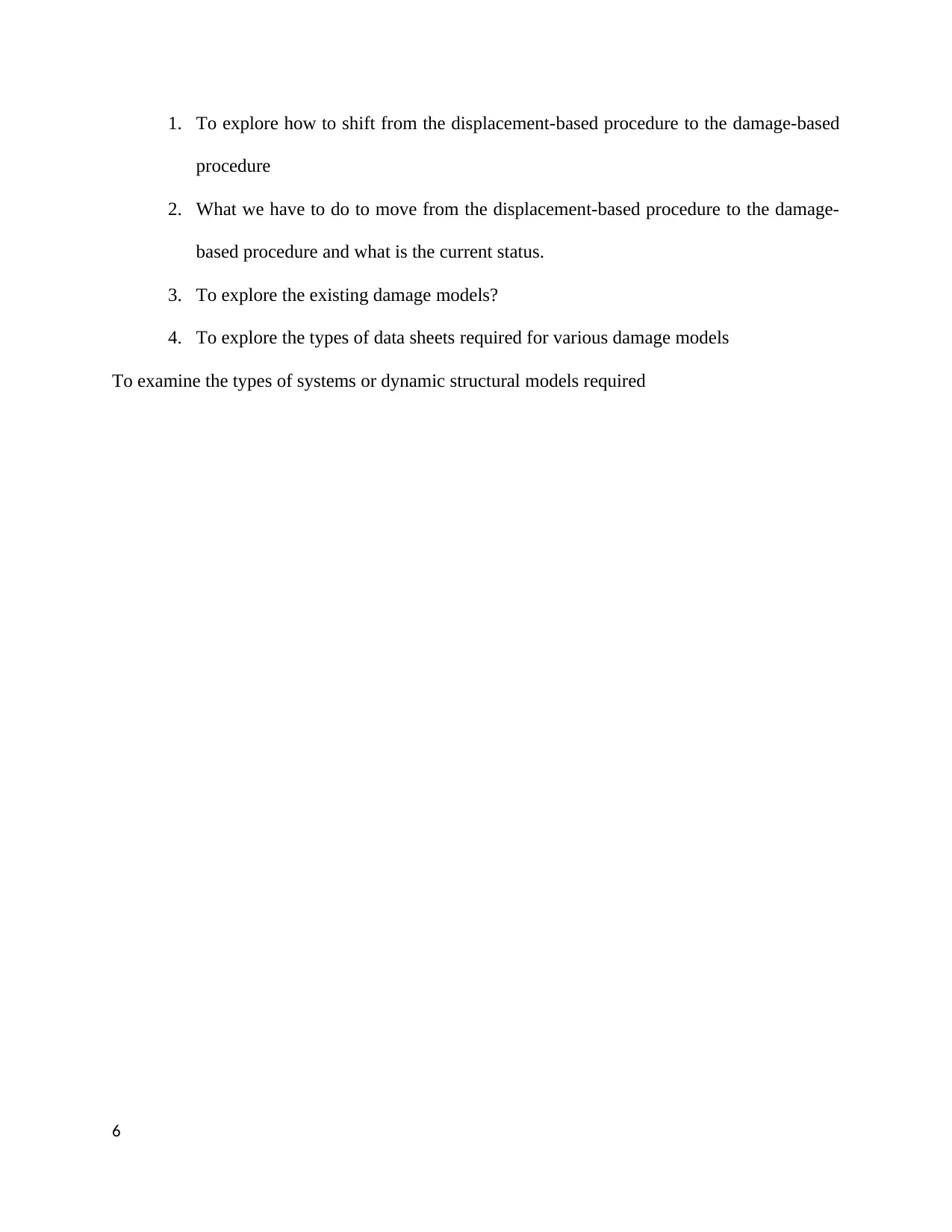
1. To explore how to shift from the displacement-based procedure to the damage-based
procedure
2. What we have to do to move from the displacement-based procedure to the damage-
based procedure and what is the current status.
3. To explore the existing damage models?
4. To explore the types of data sheets required for various damage models
To examine the types of systems or dynamic structural models required
6
procedure
2. What we have to do to move from the displacement-based procedure to the damage-
based procedure and what is the current status.
3. To explore the existing damage models?
4. To explore the types of data sheets required for various damage models
To examine the types of systems or dynamic structural models required
6
⊘ This is a preview!⊘
Do you want full access?
Subscribe today to unlock all pages.

Trusted by 1+ million students worldwide
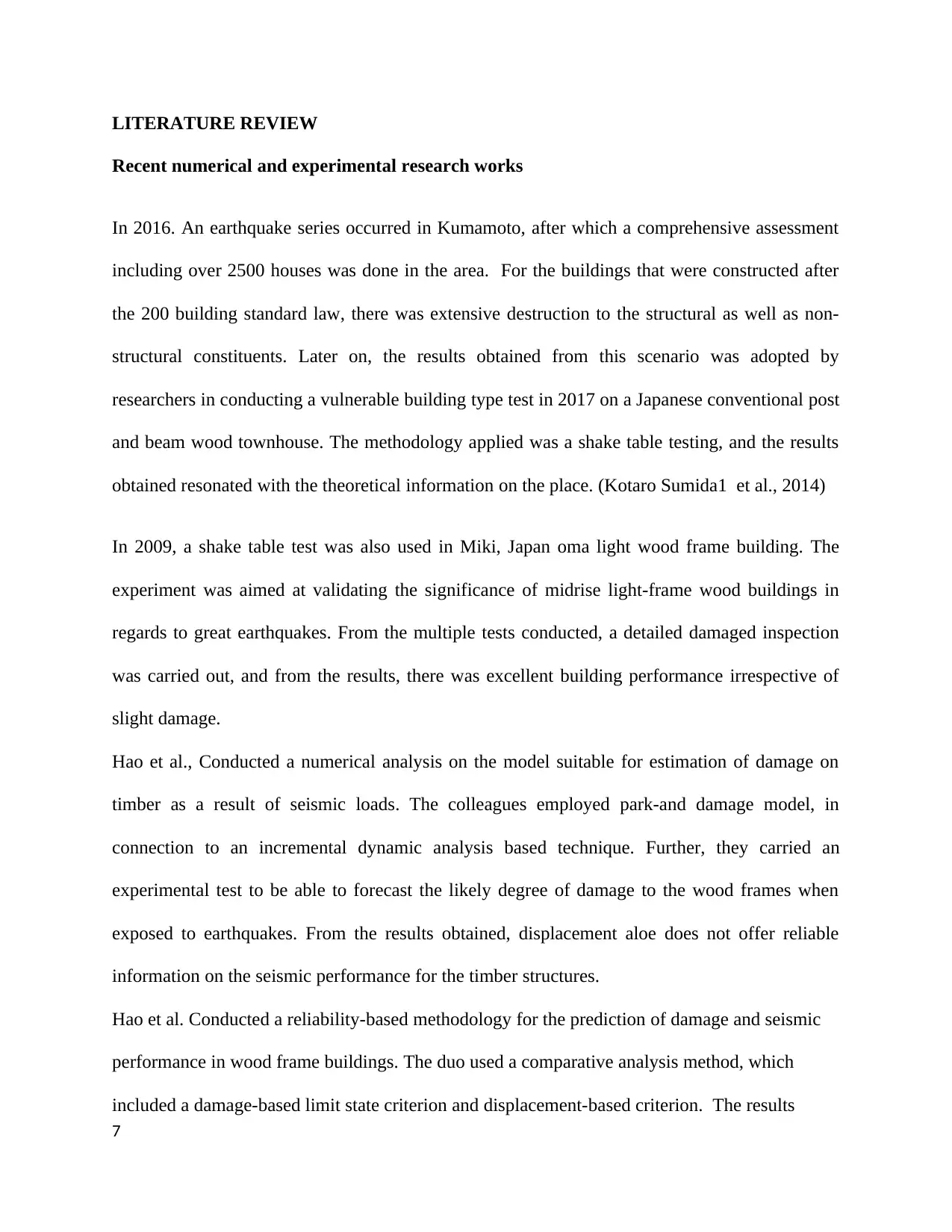
LITERATURE REVIEW
Recent numerical and experimental research works
In 2016. An earthquake series occurred in Kumamoto, after which a comprehensive assessment
including over 2500 houses was done in the area. For the buildings that were constructed after
the 200 building standard law, there was extensive destruction to the structural as well as non-
structural constituents. Later on, the results obtained from this scenario was adopted by
researchers in conducting a vulnerable building type test in 2017 on a Japanese conventional post
and beam wood townhouse. The methodology applied was a shake table testing, and the results
obtained resonated with the theoretical information on the place. (Kotaro Sumida1 et al., 2014)
In 2009, a shake table test was also used in Miki, Japan oma light wood frame building. The
experiment was aimed at validating the significance of midrise light-frame wood buildings in
regards to great earthquakes. From the multiple tests conducted, a detailed damaged inspection
was carried out, and from the results, there was excellent building performance irrespective of
slight damage.
Hao et al., Conducted a numerical analysis on the model suitable for estimation of damage on
timber as a result of seismic loads. The colleagues employed park-and damage model, in
connection to an incremental dynamic analysis based technique. Further, they carried an
experimental test to be able to forecast the likely degree of damage to the wood frames when
exposed to earthquakes. From the results obtained, displacement aloe does not offer reliable
information on the seismic performance for the timber structures.
Hao et al. Conducted a reliability-based methodology for the prediction of damage and seismic
performance in wood frame buildings. The duo used a comparative analysis method, which
included a damage-based limit state criterion and displacement-based criterion. The results
7
Recent numerical and experimental research works
In 2016. An earthquake series occurred in Kumamoto, after which a comprehensive assessment
including over 2500 houses was done in the area. For the buildings that were constructed after
the 200 building standard law, there was extensive destruction to the structural as well as non-
structural constituents. Later on, the results obtained from this scenario was adopted by
researchers in conducting a vulnerable building type test in 2017 on a Japanese conventional post
and beam wood townhouse. The methodology applied was a shake table testing, and the results
obtained resonated with the theoretical information on the place. (Kotaro Sumida1 et al., 2014)
In 2009, a shake table test was also used in Miki, Japan oma light wood frame building. The
experiment was aimed at validating the significance of midrise light-frame wood buildings in
regards to great earthquakes. From the multiple tests conducted, a detailed damaged inspection
was carried out, and from the results, there was excellent building performance irrespective of
slight damage.
Hao et al., Conducted a numerical analysis on the model suitable for estimation of damage on
timber as a result of seismic loads. The colleagues employed park-and damage model, in
connection to an incremental dynamic analysis based technique. Further, they carried an
experimental test to be able to forecast the likely degree of damage to the wood frames when
exposed to earthquakes. From the results obtained, displacement aloe does not offer reliable
information on the seismic performance for the timber structures.
Hao et al. Conducted a reliability-based methodology for the prediction of damage and seismic
performance in wood frame buildings. The duo used a comparative analysis method, which
included a damage-based limit state criterion and displacement-based criterion. The results
7
Paraphrase This Document
Need a fresh take? Get an instant paraphrase of this document with our AI Paraphraser
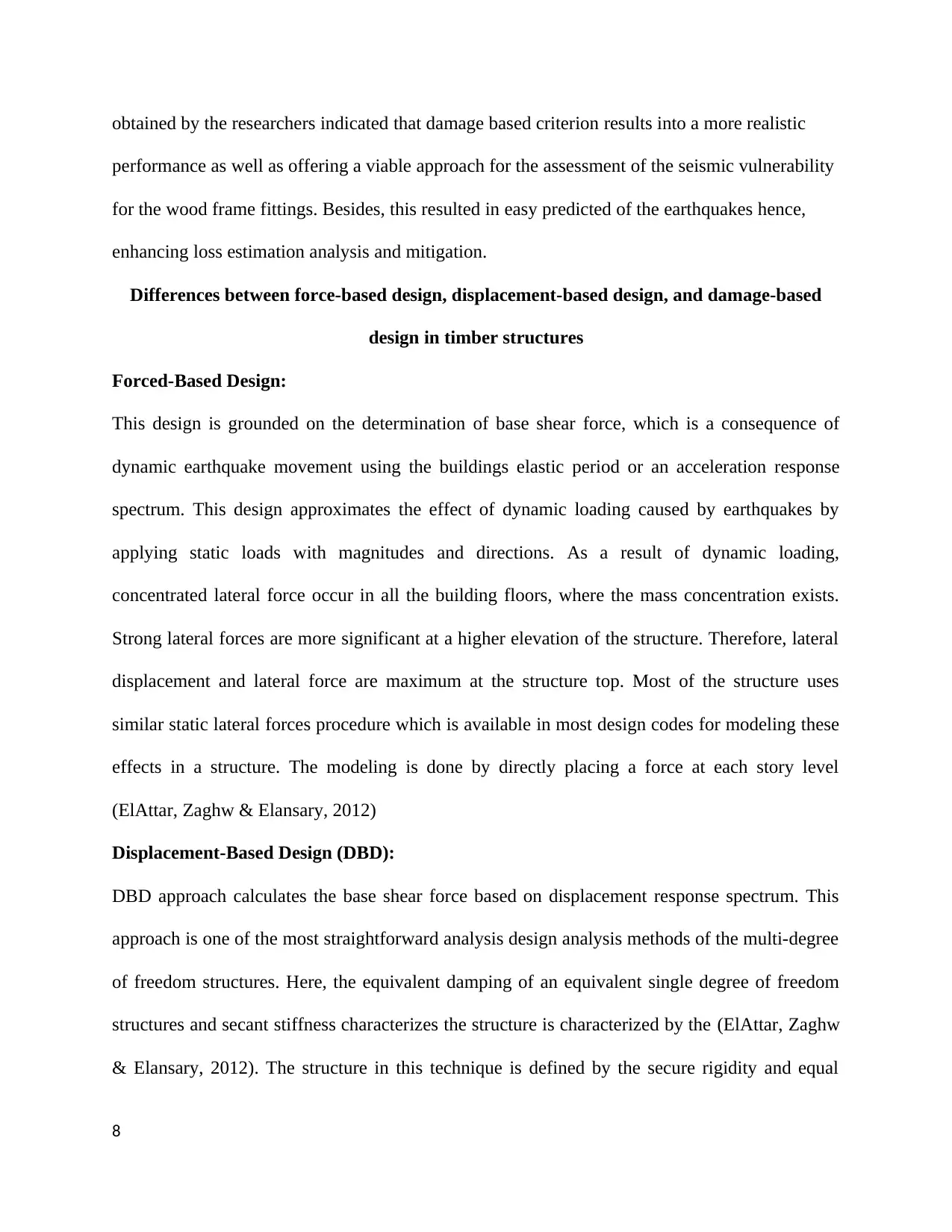
obtained by the researchers indicated that damage based criterion results into a more realistic
performance as well as offering a viable approach for the assessment of the seismic vulnerability
for the wood frame fittings. Besides, this resulted in easy predicted of the earthquakes hence,
enhancing loss estimation analysis and mitigation.
Differences between force-based design, displacement-based design, and damage-based
design in timber structures
Forced-Based Design:
This design is grounded on the determination of base shear force, which is a consequence of
dynamic earthquake movement using the buildings elastic period or an acceleration response
spectrum. This design approximates the effect of dynamic loading caused by earthquakes by
applying static loads with magnitudes and directions. As a result of dynamic loading,
concentrated lateral force occur in all the building floors, where the mass concentration exists.
Strong lateral forces are more significant at a higher elevation of the structure. Therefore, lateral
displacement and lateral force are maximum at the structure top. Most of the structure uses
similar static lateral forces procedure which is available in most design codes for modeling these
effects in a structure. The modeling is done by directly placing a force at each story level
(ElAttar, Zaghw & Elansary, 2012)
Displacement-Based Design (DBD):
DBD approach calculates the base shear force based on displacement response spectrum. This
approach is one of the most straightforward analysis design analysis methods of the multi-degree
of freedom structures. Here, the equivalent damping of an equivalent single degree of freedom
structures and secant stiffness characterizes the structure is characterized by the (ElAttar, Zaghw
& Elansary, 2012). The structure in this technique is defined by the secure rigidity and equal
8
performance as well as offering a viable approach for the assessment of the seismic vulnerability
for the wood frame fittings. Besides, this resulted in easy predicted of the earthquakes hence,
enhancing loss estimation analysis and mitigation.
Differences between force-based design, displacement-based design, and damage-based
design in timber structures
Forced-Based Design:
This design is grounded on the determination of base shear force, which is a consequence of
dynamic earthquake movement using the buildings elastic period or an acceleration response
spectrum. This design approximates the effect of dynamic loading caused by earthquakes by
applying static loads with magnitudes and directions. As a result of dynamic loading,
concentrated lateral force occur in all the building floors, where the mass concentration exists.
Strong lateral forces are more significant at a higher elevation of the structure. Therefore, lateral
displacement and lateral force are maximum at the structure top. Most of the structure uses
similar static lateral forces procedure which is available in most design codes for modeling these
effects in a structure. The modeling is done by directly placing a force at each story level
(ElAttar, Zaghw & Elansary, 2012)
Displacement-Based Design (DBD):
DBD approach calculates the base shear force based on displacement response spectrum. This
approach is one of the most straightforward analysis design analysis methods of the multi-degree
of freedom structures. Here, the equivalent damping of an equivalent single degree of freedom
structures and secant stiffness characterizes the structure is characterized by the (ElAttar, Zaghw
& Elansary, 2012). The structure in this technique is defined by the secure rigidity and equal
8

damping of a similar single degree of freedom structure. This approach of the design is about
attaining a specific shift limit state, which can be defined by non-structural drift limits or
material strain limits which are gotten from design codes present in the design level seismic
intensity.
Damage-based design model
A damage based design model makes it very easy to monitor the structural health of a
building. Nonetheless, there exists limited research information on the same. The damage based
model identifies the problem at the very initial stages using a technology that relies on fiber
optics and sensors. There exist various ways in which the damage-based design is achieved, for
instance: the use of several natural frequency shifts, also modifications in the modal properties.
In this approach, one sensor usually acts as an actuator to produce the stress waves, which gets
propagate in the timber structure surface, while the other sensors detect the stress was which are
being propagated. Cracks and other defects will thus induce an extra attenuation on the stress
wave, which is being propagated and the model since the defects by the aid of w wavelet-packet-
based damage index. So far, one of the commonly adopted damage models by researchers is the
park-and index model. The reason behind this is as a result of the model consideration of
cumulative damage failure and exceedance failure in regards to defining the structural damage
that is under earthquake. Further, this model allows for consideration of the effects resulting
from the load sequence and load path on the damage.
Proposed design
Park-Ang Damage Model:
The Park-Ang index model has been identified as one of the most common inference points
when it comes to the damage of reinforced concrete. In identifying the structural damage that is
9
attaining a specific shift limit state, which can be defined by non-structural drift limits or
material strain limits which are gotten from design codes present in the design level seismic
intensity.
Damage-based design model
A damage based design model makes it very easy to monitor the structural health of a
building. Nonetheless, there exists limited research information on the same. The damage based
model identifies the problem at the very initial stages using a technology that relies on fiber
optics and sensors. There exist various ways in which the damage-based design is achieved, for
instance: the use of several natural frequency shifts, also modifications in the modal properties.
In this approach, one sensor usually acts as an actuator to produce the stress waves, which gets
propagate in the timber structure surface, while the other sensors detect the stress was which are
being propagated. Cracks and other defects will thus induce an extra attenuation on the stress
wave, which is being propagated and the model since the defects by the aid of w wavelet-packet-
based damage index. So far, one of the commonly adopted damage models by researchers is the
park-and index model. The reason behind this is as a result of the model consideration of
cumulative damage failure and exceedance failure in regards to defining the structural damage
that is under earthquake. Further, this model allows for consideration of the effects resulting
from the load sequence and load path on the damage.
Proposed design
Park-Ang Damage Model:
The Park-Ang index model has been identified as one of the most common inference points
when it comes to the damage of reinforced concrete. In identifying the structural damage that is
9
⊘ This is a preview!⊘
Do you want full access?
Subscribe today to unlock all pages.

Trusted by 1+ million students worldwide
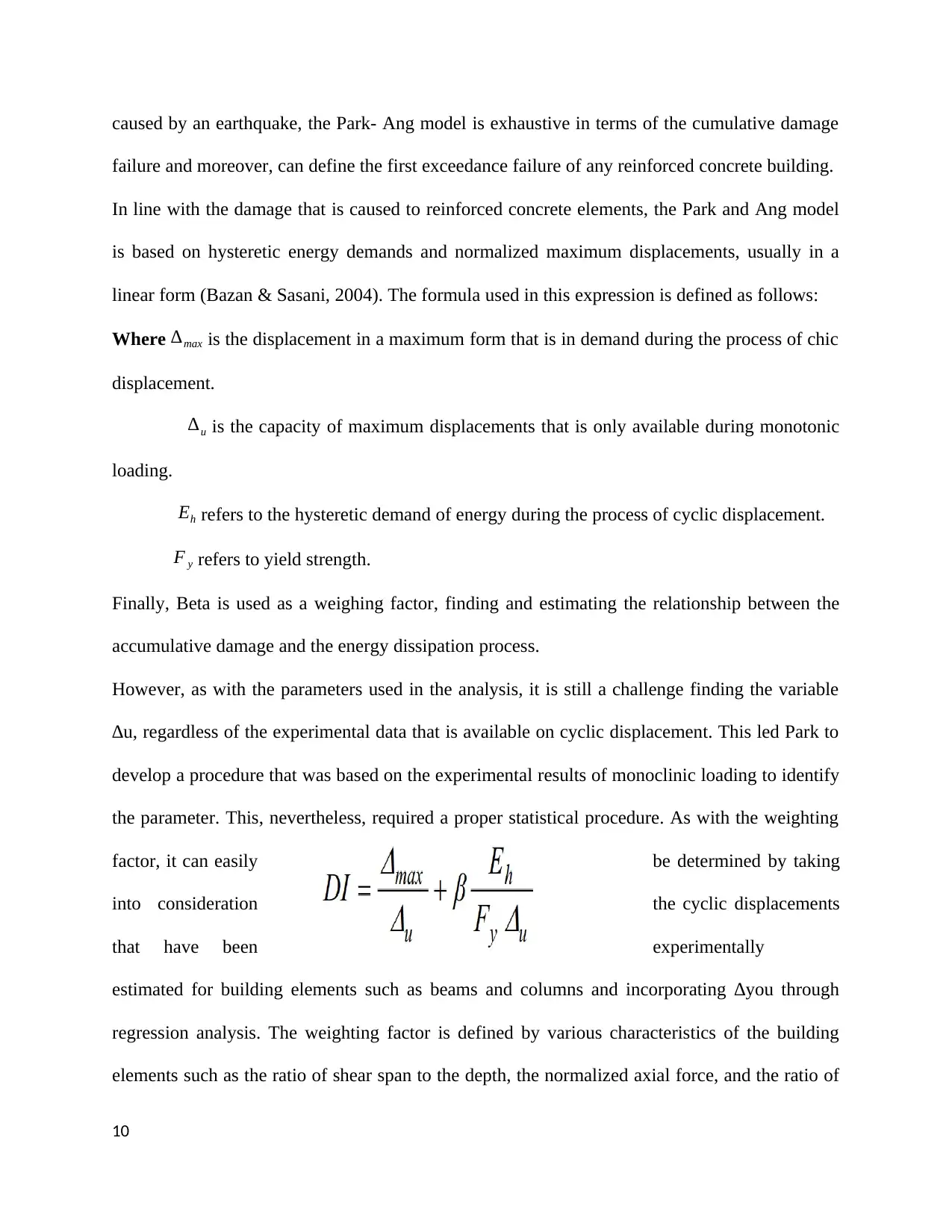
caused by an earthquake, the Park- Ang model is exhaustive in terms of the cumulative damage
failure and moreover, can define the first exceedance failure of any reinforced concrete building.
In line with the damage that is caused to reinforced concrete elements, the Park and Ang model
is based on hysteretic energy demands and normalized maximum displacements, usually in a
linear form (Bazan & Sasani, 2004). The formula used in this expression is defined as follows:
Where ∆max is the displacement in a maximum form that is in demand during the process of chic
displacement.
∆u is the capacity of maximum displacements that is only available during monotonic
loading.
Eh refers to the hysteretic demand of energy during the process of cyclic displacement.
F y refers to yield strength.
Finally, Beta is used as a weighing factor, finding and estimating the relationship between the
accumulative damage and the energy dissipation process.
However, as with the parameters used in the analysis, it is still a challenge finding the variable
∆u, regardless of the experimental data that is available on cyclic displacement. This led Park to
develop a procedure that was based on the experimental results of monoclinic loading to identify
the parameter. This, nevertheless, required a proper statistical procedure. As with the weighting
factor, it can easily be determined by taking
into consideration the cyclic displacements
that have been experimentally
estimated for building elements such as beams and columns and incorporating ∆you through
regression analysis. The weighting factor is defined by various characteristics of the building
elements such as the ratio of shear span to the depth, the normalized axial force, and the ratio of
10
failure and moreover, can define the first exceedance failure of any reinforced concrete building.
In line with the damage that is caused to reinforced concrete elements, the Park and Ang model
is based on hysteretic energy demands and normalized maximum displacements, usually in a
linear form (Bazan & Sasani, 2004). The formula used in this expression is defined as follows:
Where ∆max is the displacement in a maximum form that is in demand during the process of chic
displacement.
∆u is the capacity of maximum displacements that is only available during monotonic
loading.
Eh refers to the hysteretic demand of energy during the process of cyclic displacement.
F y refers to yield strength.
Finally, Beta is used as a weighing factor, finding and estimating the relationship between the
accumulative damage and the energy dissipation process.
However, as with the parameters used in the analysis, it is still a challenge finding the variable
∆u, regardless of the experimental data that is available on cyclic displacement. This led Park to
develop a procedure that was based on the experimental results of monoclinic loading to identify
the parameter. This, nevertheless, required a proper statistical procedure. As with the weighting
factor, it can easily be determined by taking
into consideration the cyclic displacements
that have been experimentally
estimated for building elements such as beams and columns and incorporating ∆you through
regression analysis. The weighting factor is defined by various characteristics of the building
elements such as the ratio of shear span to the depth, the normalized axial force, and the ratio of
10
Paraphrase This Document
Need a fresh take? Get an instant paraphrase of this document with our AI Paraphraser
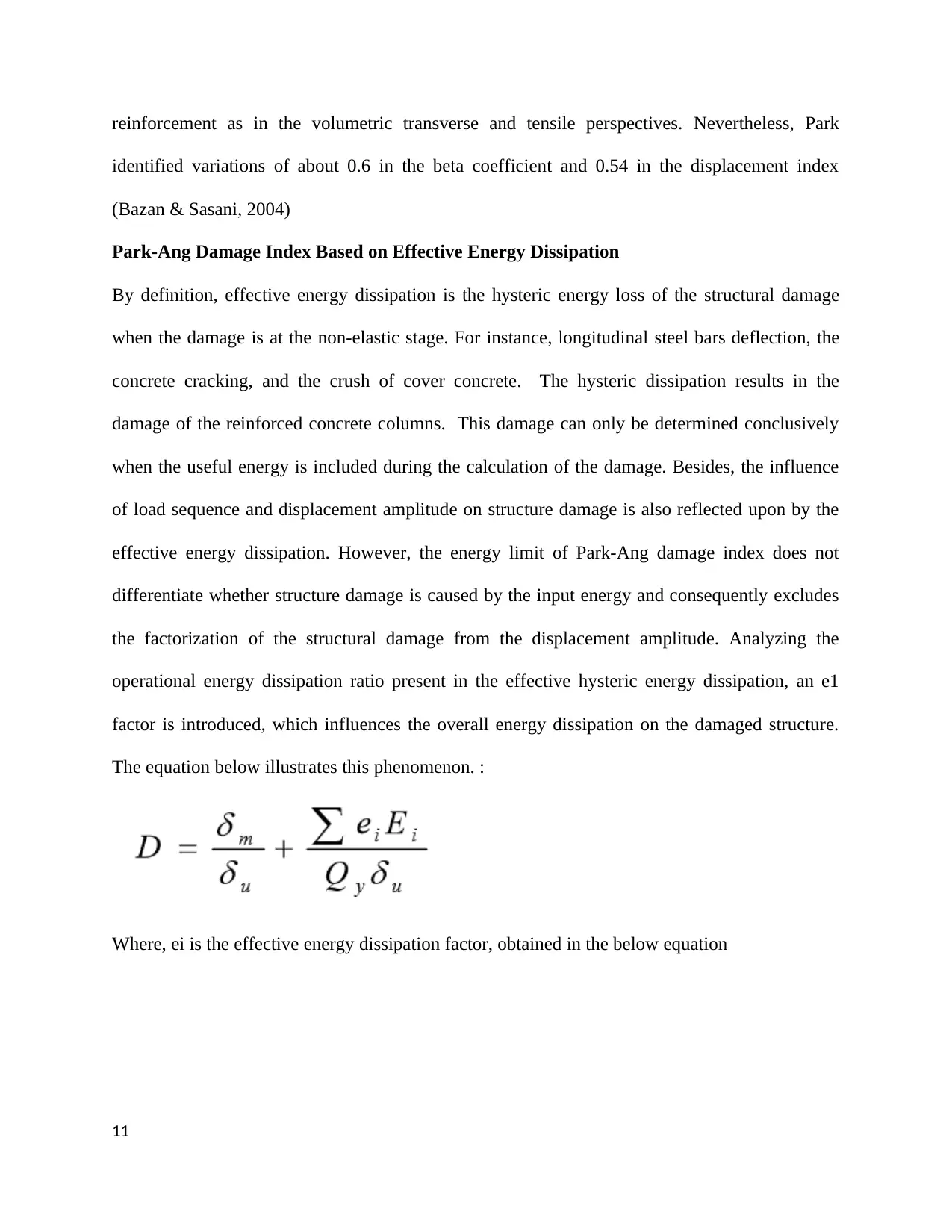
reinforcement as in the volumetric transverse and tensile perspectives. Nevertheless, Park
identified variations of about 0.6 in the beta coefficient and 0.54 in the displacement index
(Bazan & Sasani, 2004)
Park-Ang Damage Index Based on Effective Energy Dissipation
By definition, effective energy dissipation is the hysteric energy loss of the structural damage
when the damage is at the non-elastic stage. For instance, longitudinal steel bars deflection, the
concrete cracking, and the crush of cover concrete. The hysteric dissipation results in the
damage of the reinforced concrete columns. This damage can only be determined conclusively
when the useful energy is included during the calculation of the damage. Besides, the influence
of load sequence and displacement amplitude on structure damage is also reflected upon by the
effective energy dissipation. However, the energy limit of Park-Ang damage index does not
differentiate whether structure damage is caused by the input energy and consequently excludes
the factorization of the structural damage from the displacement amplitude. Analyzing the
operational energy dissipation ratio present in the effective hysteric energy dissipation, an e1
factor is introduced, which influences the overall energy dissipation on the damaged structure.
The equation below illustrates this phenomenon. :
Where, ei is the effective energy dissipation factor, obtained in the below equation
11
identified variations of about 0.6 in the beta coefficient and 0.54 in the displacement index
(Bazan & Sasani, 2004)
Park-Ang Damage Index Based on Effective Energy Dissipation
By definition, effective energy dissipation is the hysteric energy loss of the structural damage
when the damage is at the non-elastic stage. For instance, longitudinal steel bars deflection, the
concrete cracking, and the crush of cover concrete. The hysteric dissipation results in the
damage of the reinforced concrete columns. This damage can only be determined conclusively
when the useful energy is included during the calculation of the damage. Besides, the influence
of load sequence and displacement amplitude on structure damage is also reflected upon by the
effective energy dissipation. However, the energy limit of Park-Ang damage index does not
differentiate whether structure damage is caused by the input energy and consequently excludes
the factorization of the structural damage from the displacement amplitude. Analyzing the
operational energy dissipation ratio present in the effective hysteric energy dissipation, an e1
factor is introduced, which influences the overall energy dissipation on the damaged structure.
The equation below illustrates this phenomenon. :
Where, ei is the effective energy dissipation factor, obtained in the below equation
11
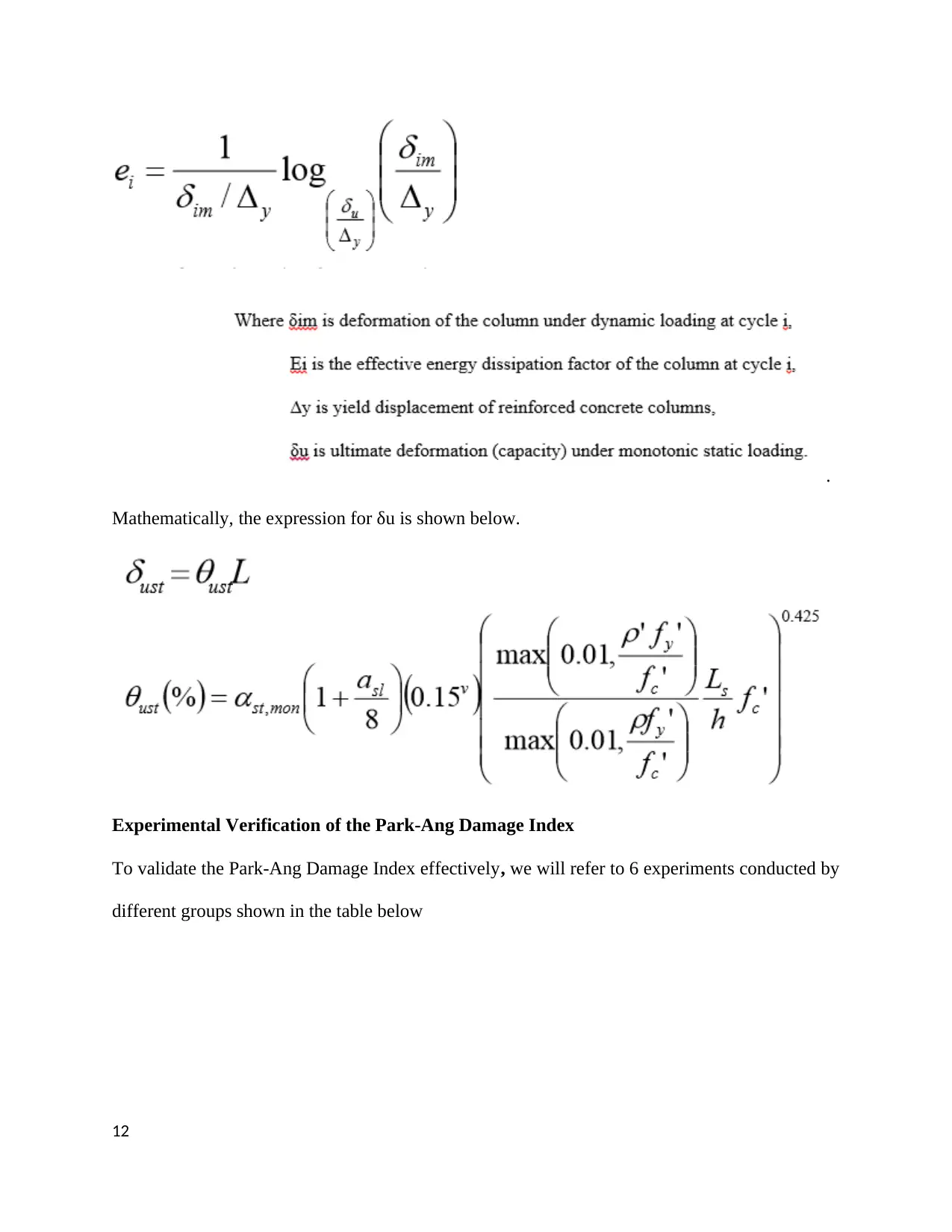
.
Mathematically, the expression for δu is shown below.
Experimental Verification of the Park-Ang Damage Index
To validate the Park-Ang Damage Index effectively, we will refer to 6 experiments conducted by
different groups shown in the table below
12
Mathematically, the expression for δu is shown below.
Experimental Verification of the Park-Ang Damage Index
To validate the Park-Ang Damage Index effectively, we will refer to 6 experiments conducted by
different groups shown in the table below
12
⊘ This is a preview!⊘
Do you want full access?
Subscribe today to unlock all pages.

Trusted by 1+ million students worldwide
1 out of 26
Related Documents
Your All-in-One AI-Powered Toolkit for Academic Success.
+13062052269
info@desklib.com
Available 24*7 on WhatsApp / Email
![[object Object]](/_next/static/media/star-bottom.7253800d.svg)
Unlock your academic potential
Copyright © 2020–2025 A2Z Services. All Rights Reserved. Developed and managed by ZUCOL.





